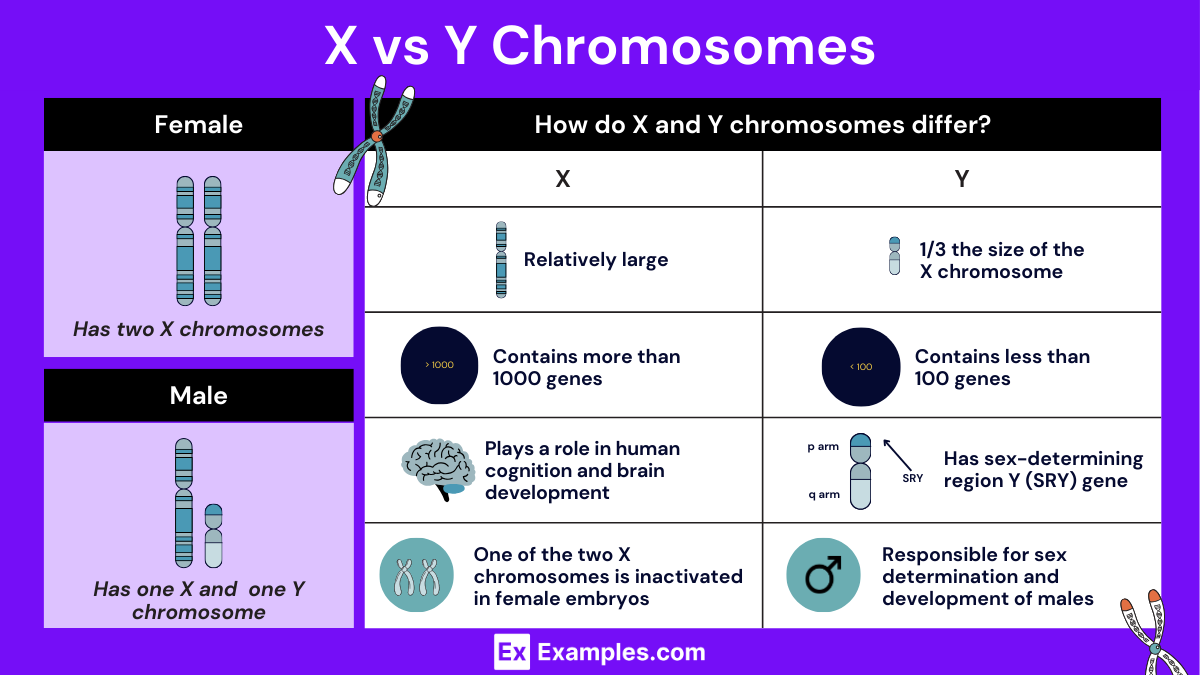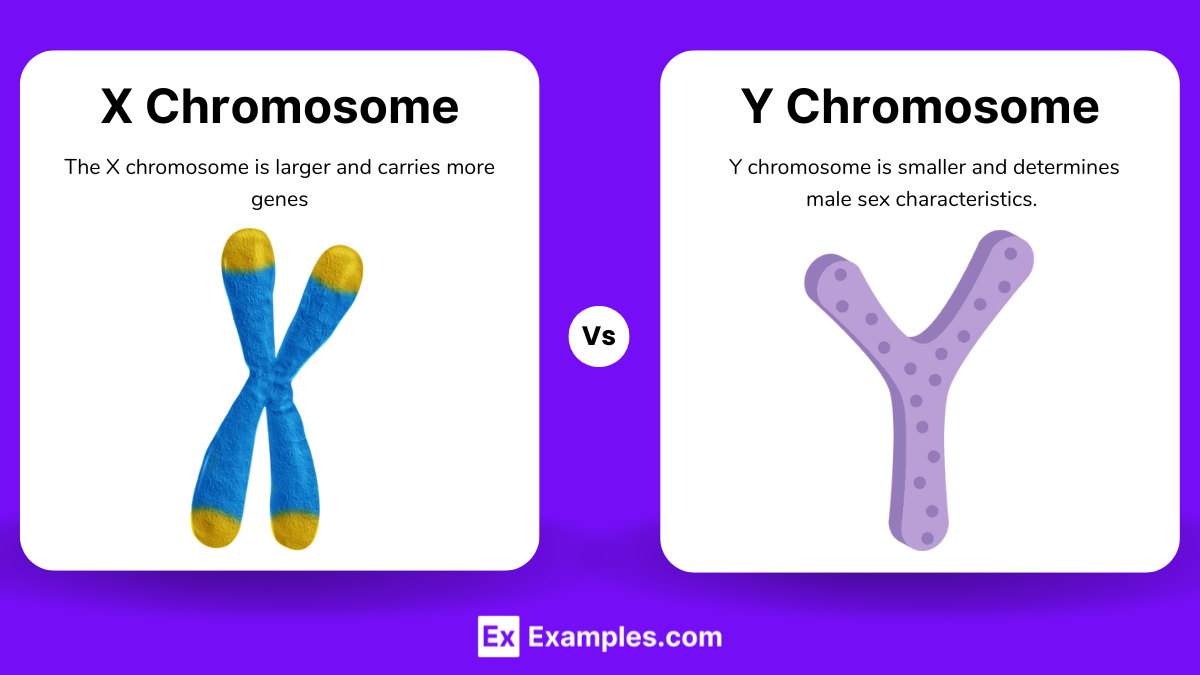X vs Y Chromosomes – Differences Explained with structure & Function
Understanding the differences between X and Y chromosomes unlocks the mysteries of human genetics. These two chromosomes determine our biological sex and influence various traits and conditions. The X chromosome carries more genes and plays a crucial role in both males and females. The Y chromosome, much smaller, is vital for male development. Grasping these distinctions helps us appreciate the complexity and beauty of human biology. Let’s delve into the fascinating world of X and Y chromosomes and see how they shape who we are.
What are X Chromosomes?
The X chromosome is one of the two sex chromosomes in humans and many other organisms, the other being the Y chromosome. X chromosomes play a crucial role in determining the sex of an individual, as well as in various biological processes and genetic inheritance.
Structure of the X Chromosome
The X chromosome is a large chromosome, containing about 155 million base pairs, which represents approximately 5% of the total DNA in cells. Some key structural features include:
- Centromere: The central part of the X chromosome, crucial for proper segregation during cell division.
- Telomeres: Protective caps at the ends of the chromosome that prevent degradation.
- Genes: The X chromosome contains more than 1,000 genes, many of which are involved in important biological functions.
Function of the X Chromosome
The X chromosome carries genes that are essential for normal development and function. Some key functions include:
- Sex Determination: In humans, females have two X chromosomes (XX), while males have one X and one Y chromosome (XY). The presence of a Y chromosome determines maleness.
- Gene Expression: The X chromosome contains genes involved in numerous bodily functions, including:
- Brain Development: Several genes on the X chromosome are critical for neurological development and cognitive function.
- Immune System: Some X-linked genes play roles in the immune response.
- Reproduction: Genes on the X chromosome are involved in reproductive system development and function.
X Inactivation
In females, one of the two X chromosomes is randomly inactivated in each cell. This process, known as X inactivation, ensures that females do not have twice as many X-linked gene products as males. The inactivated X chromosome becomes a compact structure called a Barr body.
Mechanism of X Inactivation
- Initiation: X inactivation begins early in embryonic development.
- Spread: The inactivation signal spreads along the X chromosome.
- Maintenance: Once established, X inactivation is stably maintained through subsequent cell divisions.
Disorders Linked to the X Chromosome
Several genetic disorders are linked to mutations or abnormalities in the X chromosome. These include:
- Turner Syndrome: A condition in which a female is missing one X chromosome (45, X0). It causes developmental abnormalities and infertility.
- Klinefelter Syndrome: A condition in males with an extra X chromosome (47, XXY). It leads to hypogonadism and reduced fertility.
- Hemophilia: A bleeding disorder caused by mutations in the F8 or F9 gene on the X chromosome.
- Duchenne Muscular Dystrophy: A severe muscle-wasting disease caused by mutations in the DMD gene on the X chromosome.
Evolution of the X Chromosome
The X chromosome has evolved over millions of years. Comparative studies show that the X chromosome has conserved genes across different species, highlighting its essential role in basic biological processes.
What are Y chromosomes?
The Y chromosome is one of the two sex chromosomes in humans and many other species, the other being the X chromosome. It plays a pivotal role in determining male sex characteristics and has unique features and functions.
Structure of the Y Chromosome
The Y chromosome is much smaller than the X chromosome, containing about 58 million base pairs and representing approximately 2% of the total DNA in a cell. Some key structural features include:
- Pseudoautosomal Regions (PARs): Small regions at both ends of the Y chromosome that are homologous to corresponding regions on the X chromosome. These regions allow the X and Y chromosomes to pair and recombine during meiosis.
- Male-Specific Region of the Y (MSY): The large central part of the Y chromosome that does not recombine with the X chromosome and contains the majority of Y-specific genes.
- Centromere: The central part of the Y chromosome, crucial for proper segregation during cell division.
- Telomeres: Protective caps at the ends of the chromosome that prevent degradation.
Function of the Y Chromosome
The Y chromosome carries genes essential for male sex determination and spermatogenesis. Some key functions include:
- Sex Determination: The presence of the Y chromosome, specifically the SRY gene (Sex-determining Region Y), triggers the development of male characteristics. The SRY gene initiates a cascade of events leading to the formation of testes and the production of male hormones.
- Spermatogenesis: Several genes on the Y chromosome, such as DAZ (Deleted in Azoospermia) and RBMY (RNA Binding Motif Protein, Y-linked), are crucial for the production and development of sperm cells.
Unique Features of the Y Chromosome
Lack of Recombination
Unlike most chromosomes, the majority of the Y chromosome (excluding PARs) does not undergo recombination during meiosis. This lack of recombination leads to:
- Genetic Stability: The Y chromosome is passed relatively unchanged from father to son, allowing the tracing of paternal lineage over generations.
- Accumulation of Mutations: The non-recombining region can accumulate mutations over time, which can be used to study human evolution and migration patterns.
Haplogroups
Y chromosome haplogroups are groups of similar Y chromosomes that share a common ancestor. These haplogroups are used in genetic genealogy and anthropology to trace paternal lineage and study human population history.
Disorders Linked to the Y Chromosome
Several genetic conditions and disorders are linked to abnormalities in the Y chromosome. These include:
- Y Chromosome Infertility: Deletions in certain regions of the Y chromosome, particularly the AZF (Azoospermia Factor) regions, can lead to reduced sperm production and infertility.
- Turner Syndrome: A condition in which a female is partially or completely missing an X chromosome (45, X0), and occasionally, they have cells with a Y chromosome, leading to mixed gonadal dysgenesis.
- Klinefelter Syndrome: A condition in males with an extra X chromosome (47, XXY), which can cause hypogonadism, reduced fertility, and other developmental issues.
Evolution of the Y Chromosome
The Y chromosome has evolved significantly over millions of years. It is thought to have originated from an ancestral autosome that differentiated into the Y chromosome due to the acquisition of sex-determining genes. Over time, it lost many of its original genes, retaining those crucial for male-specific functions.
Comparative Genomics
Comparative studies of Y chromosomes across different species reveal conserved elements and evolutionary adaptations, helping us understand the role and evolution of sex chromosomes in general.
Differences Between X and Y Chromosomes

| Feature | X Chromosome | Y Chromosome |
|---|---|---|
| Size | Larger, approximately 155 million base pairs | Smaller, approximately 58 million base pairs |
| Gene Content | Contains about 1,100-1,500 genes | Contains about 50-200 genes |
| Presence | Found in both males (XY) and females (XX) | Found only in males (XY) |
| Sex Determination | Does not determine sex | Determines male sex |
| Inheritance Pattern | Inherited from both parents | Inherited only from the father |
| Recombination | Can recombine with other X chromosome in females | Rarely recombines with X chromosome (only in pseudoautosomal regions) |
| Functional Role | Contains genes essential for various bodily functions | Contains genes primarily related to male sex determination and spermatogenesis |
| Dosage Compensation | Undergoes X-inactivation in females to balance gene expression | No dosage compensation required |
| Evolution | More conserved across species | More prone to mutations and deletions |
| Associated Disorders | Linked to X-linked genetic disorders like hemophilia and color blindness | Linked to Y-linked disorders like Y chromosome infertility |
Similarities Between X and Y Chromosomes
1. Presence in All Cells
- Both X and Y chromosomes are present in all cells with a nucleus.
- They are part of the 23 pairs of chromosomes in humans.
2. Sex Chromosomes
- Both X and Y chromosomes are categorized as sex chromosomes, also known as allosomes.
- They play a significant role in determining the biological sex of an individual.
3. DNA Composition
- Both chromosomes consist of DNA, which carries genetic information.
- They have similar structures, including a centromere that divides them into short (p) and long (q) arms.
4. Inheritance Pattern
- X and Y chromosomes follow a unique inheritance pattern.
- Males inherit one X chromosome from their mother and one Y chromosome from their father.
- Females inherit two X chromosomes, one from each parent.
5. Pseudogenes and Homologous Regions
- Both chromosomes contain pseudogenes, which are non-functional sequences similar to functional genes.
- They share homologous regions, especially near the telomeres and centromeres, facilitating pairing during meiosis.
6. Role in Meiosis
- Both X and Y chromosomes are involved in meiosis, the process of cell division that produces gametes (sperm and egg cells).
- During meiosis, they undergo recombination in their homologous regions, although this is limited compared to autosomes.
7. Gene Regulation
- Both chromosomes are involved in gene regulation processes.
- The X chromosome undergoes X-inactivation in females to balance gene expression between males and females.
8. Evolutionary Origin
- X and Y chromosomes are believed to have evolved from a pair of autosomes.
- Over time, they diverged but still retain some homologous sequences that indicate their common origin.
Summary Table
| Similarity | Description |
|---|---|
| Presence in All Cells | Found in all nucleated cells |
| Sex Chromosomes | Determine biological sex |
| DNA Composition | Consist of DNA with similar structures |
| Inheritance Pattern | Unique inheritance pattern in males and females |
| Pseudogenes and Homologous Regions | Contain non-functional genes and homologous regions |
| Role in Meiosis | Involved in the formation of gametes through meiosis |
| Gene Regulation | Participate in gene expression regulation |
| Evolutionary Origin | Evolved from a common ancestral pair of autosomes |
What are X and Y chromosomes?
X and Y chromosomes are sex chromosomes that determine an individual’s sex. Females have two X chromosomes (XX), while males have one X and one Y chromosome (XY).
How do X and Y chromosomes differ?
X chromosomes carry more genes and are larger than Y chromosomes. Y chromosomes contain genes primarily related to male sex determination and spermatogenesis.
What is the function of the X chromosome?
The X chromosome carries genes essential for various bodily functions, including reproduction, development, and immune response.
What is the function of the Y chromosome?
The Y chromosome determines male sex and carries genes responsible for male development and spermatogenesis.
How do X and Y chromosomes determine sex?
Sex is determined by the presence of X and Y chromosomes. XX results in a female, and XY results in a male.
Can females have a Y chromosome?
No, females typically have two X chromosomes (XX). The presence of a Y chromosome generally results in a male.
Can males have two X chromosomes?
No, typical males have one X and one Y chromosome (XY). Some males can have XXY due to Klinefelter syndrome, a genetic condition.
What is X-inactivation?
X-inactivation is a process in females where one of the two X chromosomes is randomly inactivated to balance gene expression with males.
Do X and Y chromosomes recombine?
X and Y chromosomes rarely recombine. Recombination occurs in specific regions called pseudoautosomal regions during meiosis.
What genetic disorders are linked to X and Y chromosomes?
Genetic disorders linked to X and Y chromosomes include Turner syndrome (XO), Klinefelter syndrome (XXY), and X-linked conditions like hemophilia and Duchenne muscular dystrophy.



